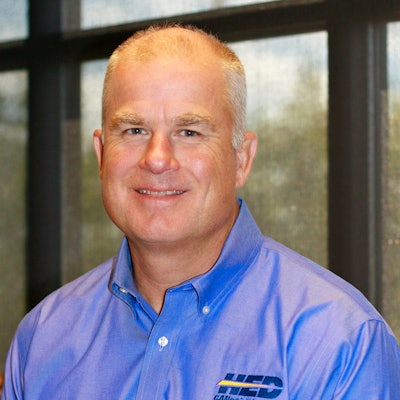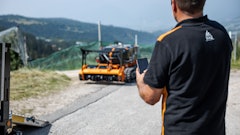
responses submitted by Paul Ludwig, CEO, HED, Inc.
Global Markets
Are there new regions of interest? What particular industry or equipment type are you looking to expand in these regions and why?
In addition to South Africa, South Korea, Turkey and the EU, we see strong potential in Australia and Chile. The verticals driving new opportunity are HED® traditional markets / traditional control and HMI products – Construction, Lifting Platforms, Material Handling, Fire and Emergency and even Defense. In South Africa and Chile, Mining is a hot market space for HED® Telematics products.
Diesel vs. Electric
What would electric power sources have to achieve in order to replace the diesel engine for heavy-duty applications?
Portability longevity are the major advancements for electrical power. This combined with the efficiency gains in hydraulics and automation will drive the conversion
How do the diesel bans in several major cities around the world play into the direction your company is taking for electric vehicle development, if at all?
The controllers, displays, and telematics units we produce are typically powered by the vehicle’s existing DC power system – so we already have systems in the field on all-electric vehicles. These systems range from our traditional hydraulic control systems to all-electric controls such as monitoring the charging circuit.
What do you think is the next step for emissions regulations after Tier 4 Final and Stage V?
Not being a manufacture of engines, HED tends to see the effects of emission regulations through HMI requirements – displays needing to show particulate regenerations, after treatment fluid levels, etc.. One area that we have seen growth in regulations past Stage V is monitoring and reporting systems – utilizing telematics offerings to track machine active times and monitor emission levels for verification of satisfying regulation requirements. HED has deployed CANect Telematics devices in support of these monitoring regulations that are currently being required by some major cities – and similar to the diesel bans, we expect these monitoring regulations to be adopted by more cities prior to reaching a national (US) or larger markets (Europe).
IoT & Connectivity
How is your company investing in IoT services and opportunities?
HED sees tremendous value and opportunity within IoT. Our CANect Telematics portfolio directly speaks to this as we’ve seen, and admittedly helped drive the adoption of IoT within the Off-Highway OEM markets for many years. What started out as Data Logging, our solution has grown into a fully configurable Telematics platform leveraging the latest IoT technologies like: Cloud Services for data storage and web interfaces for visualization of vehicle data, Edge Computing to decrease data transmission costs while enabling on-vehicle machine learning and Data Analytics for vehicle prognostics and performance monitoring. As you start stitching each of these together as HED is doing today, you can offer things like AI and Autonomous capabilities.
Do you see a path toward the use of AI, VR or AR in your manufacturing processes, or even on board the vehicle itself?
We definitely see, and are currently working toward the use of AI, VR, and AR within a number of our customers’ vehicle solutions. Each of these are built upon other capabilities and done so in a manner to provide specific functionality like remote control of a vehicle. An example of this is how HED has deployed solutions that remotely control non-critical vehicle functions like lighting, HVAC, and video which will be leveraged in each of these technologies in the future. By phasing in these foundational capabilities now we can provide vehicle users and owners valuable functionality today while continuing to build out the more extensive remote-control application which requires safety and redundancy advancements. As these types of advancements are completed and deployed in the coming years you'll start to see the AI, VR, and AR capabilities come to fruition in the off-highway market.
How do you see connectivity and machine learning changing the vehicle landscape in the next decade?
There is no question that it will change the vehicle landscape over the next decade. How that occurs, at what rate and at what cost are the harder question. The key is to build and design in a modular format so that as technologies evolve, like cell connectivity moving from 4G to 5G, you can upgrade that piece of your solution at a relatively low cost without losing complete functionality of the vehicle or solution. Now there is a balance between modular design and consolidation that must occur so that you don’t overspend today in the fear of the future that could be.
Automation & Smart Systems
What smart systems or components does your company currently offer?
HED’s CAN-based control solutions enable OEMs to deploy smart controls systems on their vehicles. With the combination of our controllers and application programming tools, customers are able to automate control functions on the vehicle (i.e., picking up and emptying a trash can), smooth hydraulic movements (ramp-up and ramp-down). These systems become smart by notifying the operator if any system faults or error messages have occurred, and provide recommended action to the operator, supported with on-device videos and troubleshooting guides to expedite repairs.
How will that portfolio be expanding in the near future? What customer/industry demands drove these future developments?
Customers are clear with their goals for use of smart technology: Improve safety, improve vehicle and operator performance, reduce downtime and lower cost of ownership. We are helping customers answer these challenges with our CANect telematics portfolio. Our CANect platform automates functions as required (disable vehicle functions when outside a geofence or after curfew hours) but also interacts effectively with the vehicle operator to automate key processes such as a guided workflow to start-up/inspect vehicle readiness each day prior to heading out. Finally, a smart telematics solution will continually put the right information in the hands of the right people via back-office data presentation or automated alerts via email/text to notify fleet managers live time of any vehicle operating or safety issues that require immediate human interaction. So the concepts of “smart” systems can still incorporate human interaction. To minimize the cost of sending data to the users, we will continue to drive Edge Computing capabilities within our hardware, which allows computations and decisions to be made right on the module without the need to send that data to the cloud for post-processing and analysis. Saves time. Saves money.
How do you see the timeline of vehicle automation unfolding in the coming years?
In the next few years we will continue to move toward stronger data analysis which will enable self-diagnosing systems that accurately predict eminent failures (before they occur) or quickly resolve unexpected failures and breakdowns. Regarding fully autonomous (drive-less) vehicles, while they have emerged in mining and will quickly follow in over-the-road trucks as safety implications and infrastructure requirements are handled, the majority of heavy duty vehicle markets we serve, including fire & rescue, cranes and utility trucks, a passenger will continue to be aboard to perform a duty once the vehicle arrives at the job site for the foreseeable future.
Managing the Data Trend
Since the onset of Big Data several years ago, how has data become an integrated part of your design and development process?
The utilization of Big Data has shifted since the onset where companies are more concerned with interesting or valuable data rather than the original concept of collect all data. This is a key part of HED’s design and development processes as we know that our customers are looking for agile solutions that can be adjusted easily over their life to collect the pertinent information they need to solve their challenges or provide a higher level of services to their customers. By taking this approach our customers can collect the data that is of value today, while having the ability to extract additional or different data in the future with a software configuration change rather than having to change out their entire solution. Providing a solution life cycle that includes the flexibility to redefine the key outputs is a tremendous benefit that increases Return On Investment and lowers Total Cost of Ownership.
What challenges remain or lay ahead for the continued and accelerated flow of data?
It’s the crystal ball effect, not knowing what future technologies or capabilities will bring is the biggest challenge since any solution being built today has to be built on tech that includes cloud services, transport layers (cell, WiFi, satellite), and on-vehicle communications. The flow of data requires collection, transport, aggregation, storage, visualization and analytics which span each of these technologies in different ways and the continuing changes in each has a direct affect on the longevity of any solution. If not properly designed and defined the sheer volume of data available from a Telematics solution would be crippling, which is why HED works with each of their customers on defining a data strategy that focuses on valuable data and how it can be visualized based on the end-users needs. By taking this approach you’re able to deliver the right information, to the right people, at the right time
Challenges & Opportunities
What excites you about the future of the heavy-duty vehicle market?
We are at an exciting time in the heavy-duty vehicle space. Our customers continue to explore how electronics can improve vehicle safety, reliability and productivity. We are working side-by-side with our customers to create innovative solutions that automate work functions, simplify vehicle maintenance and reduce cost of ownership. Intelligent controls systems and telematics solutions provide a real ROI to the vehicle owner when designed to automate and simplify the ownership experience. When a support tech can remotely view on-vehicle issues and interact real time via our CANect View tool, a vehicle issue can be resolved in minutes instead of days, fixed at a fraction of the cost by leveraging the knowledge and expertise of remote resources.
What ancillary sectors outside your core market or area of expertise are you keeping tabs on and why?
We at HED monitor the passenger car market, since that space has the scale allowing continued innovation in intelligent vehicles, including autonomous platforms. Think smart braking, lane assist and collision avoidance. As those new capabilities are successfully deployed and social, safety and legal issues are addressed in passenger car applications, these new technologies will quickly be adopted in the heavy duty vehicle space.




















